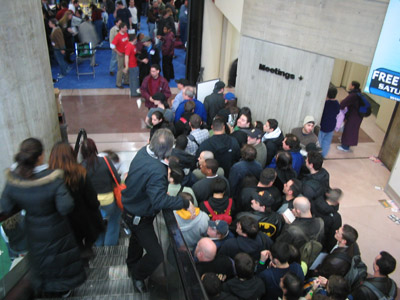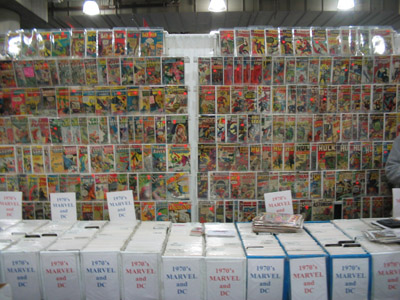|
|
 |
|
The
terminus of this mob was 2 blocks/2 hours away!
|
Things to note when you're
dealing in this medium: independent specialty retailers drive the business (contributing
over 70% of revenues to some publishers [![]() 2])
and most of them are owned by geeky, old geezers, with no desire to decorate
a store, let alone a section of a convention floor for three tables holding
a bunch of dusty old boxes. Many of these geeks are in the business because
they love comics, not, ahem, the business. Typical anti-corporation supporters
of the artists who bring them so much pleasure, they fail to organize, chain-up,
and remain at the mercy of the gorillas in the business: Marvel
Comics (with a 42% share) and DC Comics (with
a 35% share) (
2])
and most of them are owned by geeky, old geezers, with no desire to decorate
a store, let alone a section of a convention floor for three tables holding
a bunch of dusty old boxes. Many of these geeks are in the business because
they love comics, not, ahem, the business. Typical anti-corporation supporters
of the artists who bring them so much pleasure, they fail to organize, chain-up,
and remain at the mercy of the gorillas in the business: Marvel
Comics (with a 42% share) and DC Comics (with
a 35% share) (![]() 3).
Ironically, despite their original lack of pricing power, publishers have become
increasingly less dependent on retailers, relying on advertising sales, licensing,
and toys for growth. (Today, direct retailing, or distribution of comics to
mass market through specialty retailers, can ideally account for approximately
10% of a publisher's revenues [
3).
Ironically, despite their original lack of pricing power, publishers have become
increasingly less dependent on retailers, relying on advertising sales, licensing,
and toys for growth. (Today, direct retailing, or distribution of comics to
mass market through specialty retailers, can ideally account for approximately
10% of a publisher's revenues [![]() 4]).
4]).
 |
|
They
accept Visa, Mastercard, Arms, and Legs...
|
So, after allowing their distinct advantage to evaporate, and with so many alternatives for their kids besides taking over the shop, traditional comic book retailers have seen their business erode disingenuously and have come to depend heavily on the secondary market, primarily aggregating comics from their Golden, Silver, and Bronze ages, pre-1960s, 1960s, and 1970s, respectively, to survive. And these collections, as you might expect, attract a specific, die-hard group of fans, particularly, as some prices can easily be in the hundreds and even tens of thousands.
After speaking with some staff of the trade organizers, Reed Exhibitions, about the volume of fans who schlepped from all over the eastern seaboard for this convention, only to have it shut down on them repeatedly by those pesky fire marshals, it's clear they didn't anticipate that sort of response. But why not? For decades, it was an open industry secret that comic book fans were regarded and treated like kids and zombies. Purchasing a comic book wasn't like purchasing an issue of, say, New York Magazine, you didn't buy it to read, and if you read it, you didn't actually learn anything, and when you were done, there was very little recognized value. Of course, who would have thought otherwise during the 50s, 60s, and 70s. Even as early as the 90s, the concept of intrinsic value wasn't fully realized until eBay facilitated it. Just why did fans place so much value on such useless and old content, with no business value?
 |
|
This
is not a paid actor.
|
As a comic book enthusiast
and former collector for nearly 20 years myself, I can attest to why I value
my own collection so much, why I used to spend countless hours preoccupied with
their care and organization, why I used to tingle at completing a storyline
or meeting an artist, and why I gladly "invested" over $300 in comic
books at this recent convention. First and foremost, I learned to love to read
with comic books. They permitted my imagination to flourish in ways I couldn't
have foreseen while collecting, but I certainly appreciate today (as do you
if you've enjoyed any of the creative ways we tackle research topics here).
I learned to appreciate diversity and acquired a sense of financial literacy
normally gained at a young age by running lemonade stands or paper routes. But
most importantly, what I derived from my collection was that no matter how many
times I didn't get picked to play on the team, or how many times I couldn't
get the girl, comic book stories were always there to make me feel better. How
do you place value on that? Simple, the secondary market is how. The secondary
market allows those feelings to take a tangible value. It allows old, useless
content to become valuable when there is no benchmark to value them. And most
importantly, it's just great fun to hunt down and haggle over price when you
get what you want and the seller gets what they want!
(1) "My Day in a Mob: Blackout 2003"
(2) Marvel Comics Annual Report: http://www.sec.gov/Archives/edgar/data/933730/000111667905000688/form10k-2004.txt
(3) Diamond Comic Distributors
(4) al berrios & co.
analysis.
|
|